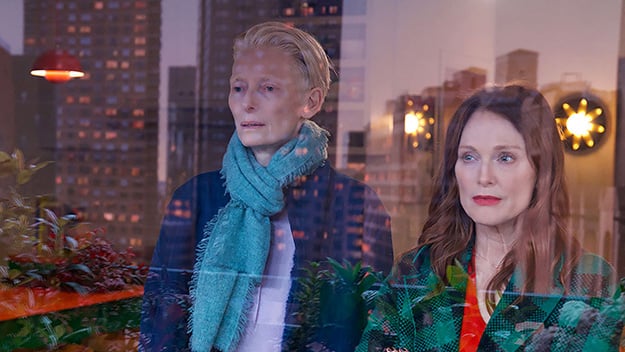No Vampires Today, Because We Are Reflecting On:
- two aging filmmakers
- repertory screenings
- Czech feminism
- a scary theme park
- fruit mysteries solved!
Thanks to Miller for bouncing back some articles this week. Send articles throughout the week to ploughmanplods [at] gmail, post articles from the past week below for discussion, and Have a Happy Friday!
Film Comment‘s Molly Haskell writes from the New York Film Festival about the latest offerings from Pedro Almodóvar and David Cronenberg:
To speak of David Cronenberg and Pedro Almodóvar in the same breath is not as much of a stretch as it might seem. With a morbid theatricality on the one hand and flamboyant histrionics on the other, both have played around with the permutations of the flesh. Almodóvar’s body-horror efforts include reincarnation via live-skin grafting in The Skin I Live In (2011), and Talk to Her (2002), in which two men become obsessed with the comatose women for whom they are caring—a premise as creepy as anything in Cronenberg’s filmography. Even more to the point, both directors are on the far side of 70—or 80 in Cronenberg’s case—and in a retrospective mood. Almodóvar hasn’t staged his own death, but the woefully impaired director played by Antonio Banderas in his Pain and Glory (2019) comes close.
Abe Beame surveys the surge in repertory screenings, and the motivations behind them, for The Ringer:
Skeptics may bump on the manner in which studios seem to be re-embracing theater exhibition—by owning the theaters—creating the monopoly the Paramount Decrees were meant to prevent and potentially, eventually, threatening independent theatrical exhibition. But the investments are clear indications that studios view theatrical exhibition, even repertory screenings, as part of the movie-watching experience. [Bloomberg News entertainment reporter Lucas] Shaw views it as a limited opportunity for studios to gain a level of intimacy and familiarity with a sliver of their clientele that repertory theaters have had access to for decades. “The [Alamo] acquisition is interesting because it’s smaller, not a competitor to AMC or Regal,” he says. “I view it as more experimental, seeing what [Sony] can learn about movie consumers.”
At Metrograph (to promote a repretory screening!), Nick Pinkerton finds a link between an overlooked feminist Czech filmmaker and Solute fave Charles Willeford:
The role of food in Murdering the Devil, as enticement and ultimately as weapon, recalls the work of that most epicurean of American genre writers, Charles Willeford. Willeford’s fiction is filled with descriptions of meals, palaver about recipes, and observations about gendered relations to the dining table; for example, in his 1962 novel Cockfighter, narrator Frank Mansfield, being stuffed to the gills by a ladyfriend, observes: “I believe women really do like to see men eat, especially when they’re fond of the man concerned, and he’s eating food they’ve prepared for him. I have never denied any woman the dubious pleasure of watching me eat. Outside of taking care of a man’s needs, women don’t get much pleasure out of life anyway.” The author’s stated views on the subject, considerably more nuanced than those of his creation, are further articulated in a 1972 column in the Miami Herald by Betsy Poller, who would become Willeford’s third wife, titled “Food Used as Weapon: ‘Rape in the Kitchen.’” In the piece Willeford expostulates a theory—drawn, he says, from “Kate Millet’s explanation of the term ‘nurturance’”—that certain women take to overfeeding their men into an early grave as a form of vengeance on their partners; “This is deliberate aggression,” says Willeford, “The only legitimate retaliation she can get.”
For The LA Review of Books, Brittany Menjivar reviews Halloween Horror Nights at Universal Studios in California:
My first stop after rope drop was the Terror Tram, a version of Universal’s studio back-lot tour focusing on horror IP. During the day, guests can merely gaze upon the sets where Psycho (1960) was filmed; at Horror Nights, they exit the vehicle to wander past Bates Motel and even greet its mysterious owner. This year, the experience was sponsored by Blumhouse, so we came face-to-face with their villains. (Tragically, Mother was not one of them.) M3GAN, the evil robot doll from the 2022 film of the same name, shimmied to and fro, replicating the viral scene from the trailer, as various other baddies chased us down with chain saws. The Grabber, Ethan Hawke’s murderous magician from The Black Phone (2022), was present, as were criminals from The Purge (2013) and that weird guy in the baby mask from Happy Death Day (2017). Since this maze is outdoors, there’s more space for actors to play around—and they will, if you give them the opportunity. When I asked the Grabber for a balloon, he reached out to offer one to me, just to lunge at my stomach with his knife while I was distracted.
In Smithsonian Magazine, talks to the “fruit detective,” a scientist who has found clues leading to disappeared fruit varieties in paintings:
Dalla Ragione has spent more than a decade scouring the masterpieces of 15th- and 16th-century art for answers to one of the great questions of Italian agriculture: Whatever happened to the boisterous selection of fruits that, for centuries, were a celebrated part of Italian cuisine and culture? Slowly and indefatigably, she has been rediscovering those fruits, first in archives and paintings and then, incredibly, in small forgotten plots across Italy. Her nonprofit, Archeologia Arborea, is helping farmers and governments around the world preserve and even bring back into cultivation all manner of forgotten fruits. In the process, Dalla Ragione has become a globally renowned fruit detective, by recognizing in her country’s Renaissance artworks not only exceptional examples of cultural patrimony but also hidden messages from a bygone era of genetic abundance that can offer clues about how to recover what was seemingly lost.

